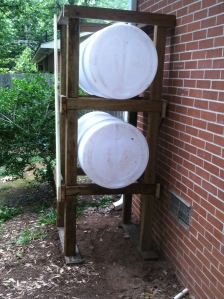
I woke up with an Olla (pronounced “oy-yah”) in my inbox from John Robb of Resilient Communities.
What’s an Olla?
It’s a simple unglazed clay pot that is buried in the ground near plants with the neck of the pot above ground. They typically have a wide, bulb-like base with a narrow neck. The porous walls of the olla allow water to wick to the plant’s root zone.
I’ve looked at the 2-liter plastic soda bottles buried next to plants for irrigation. The problem with those is that there’s no way to regulate the flow of water to plants.
Ollas are different. They seep water when the plants and surrounding dirt need it. They act as a moisture equalizer. The unglazed clay pots dispense water only when needed. Basic physics here.
 After last year’s drought, we ramped up our rainwater collection system (just added two more in a tower) in our backyard pictured below, I’m thinking ollas would help conserve even more water in our garden.
After last year’s drought, we ramped up our rainwater collection system (just added two more in a tower) in our backyard pictured below, I’m thinking ollas would help conserve even more water in our garden.
Two 55 gallon barrels stacked to give us more water and water pressure. Here are some benefits of using ollas that I’ve discovered and wanted to share with you.
Benefits of Ollas
- They water the roots instead of the surface of your garden or raised bed preventing soil compaction
- The dry surface of your garden deters weed growth
- Runoff and evaporation are eliminated giving 100% application efficiency
- The clay pots only need to be filled 1 or 2 times per week depending on climate
- Reduces water usage by 50 to 70% making your collected rainwater last even longer
- Cuts the amount of time needed for watering with conventional methods
- Adding fertilizer to the olla will feed the plants as it waters
One company, Dripping Springs Ollas, was started in 2011 and makes and distributes ollas. Click here to find a Dripping Springs Ollas vendor near you. Their ollas sell for around $32 each. If you don’t want to invest the money for a commercially made olla, you can always go the DIY route.
DIY Ollas
Check out these links for tutorials on making your own ollas:
-
- Build your olla over at Global Bucket
- Close to the Dirt built these for gardening in Central Texas
If you’ve ever used ollas, we’d like to hear your experience. Drop us a note in the comments or email us at survivalsherpa (at) gmail (dot) com.
Keep doing the stuff,
Todd
